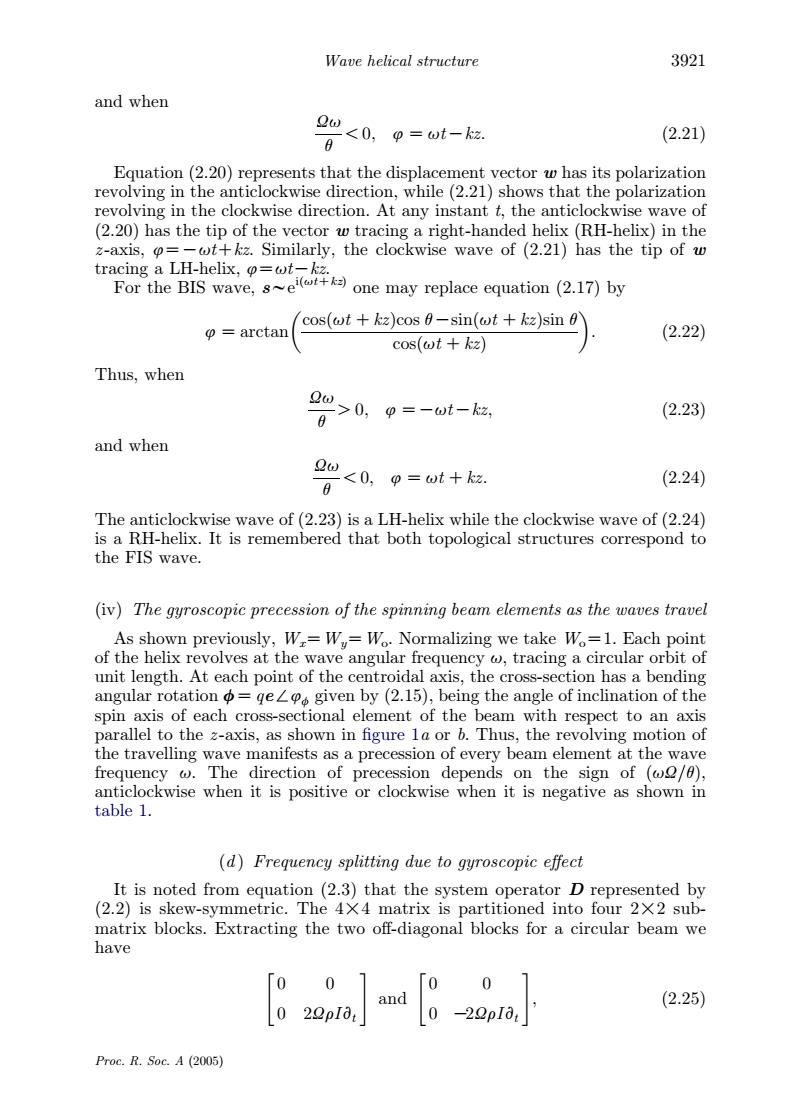正在加载图片...

Wave helical structure 3921 and when 2w <0,=wt-kz. (2.21) Equation(2.20)represents that the displacement vector w has its polarization revolving in the anticlockwise direction,while(2.21)shows that the polarization revolving in the clockwise direction.At any instant t,the anticlockwise wave of (2.20)has the tip of the vector w tracing a right-handed helix(RH-helix)in the z-axis,o=-wt+kz.Similarly,the clockwise wave of (2.21)has the tip of w tracing a LH-helix,=ot-kz. For the BIS wave,se one may replace equation (2.17)by cos(wt +kz)cos 6-sin(@t +kz)sin 0 arctan (2.22) cos(@t+kz) Thus,when >0,9=-wt-, 2w (2.23) and when 2u<0,p=wt+k2. (2.24) The anticlockwise wave of(2.23)is a LH-helix while the clockwise wave of(2.24) is a RH-helix.It is remembered that both topological structures correspond to the FIS wave. (iv)The gyroscopic precession of the spinning beam elements as the waves travel As shown previously,Wr=W=Wo.Normalizing we take Wo=1.Each point of the helix revolves at the wave angular frequency @tracing a circular orbit of unit length.At each point of the centroidal axis,the cross-section has a bending angular rotation o=geo given by (2.15),being the angle of inclination of the spin axis of each cross-sectional element of the beam with respect to an axis parallel to the z-axis,as shown in figure 1a or b.Thus,the revolving motion of the travelling wave manifests as a precession of every beam element at the wave frequency @The direction of precession depends on the sign of (@/0), anticlockwise when it is positive or clockwise when it is negative as shown in table 1. (d)Frequency splitting due to gyroscopic effect It is noted from equation (2.3)that the system operator D represented by (2.2)is skew-symmetric.The 4X4 matrix is partitioned into four 2X2 sub- matrix blocks.Extracting the two off-diagonal blocks for a circular beam we have 0 0 0 0 (2.25) 0 Proc.R.Soc.A(2005)and when Uu q !0; 4 ZutKkz: ð2:21Þ Equation (2.20) represents that the displacement vector w has its polarization revolving in the anticlockwise direction, while (2.21) shows that the polarization revolving in the clockwise direction. At any instant t, the anticlockwise wave of (2.20) has the tip of the vector w tracing a right-handed helix (RH-helix) in the z -axis, 4ZKutCkz. Similarly, the clockwise wave of (2.21) has the tip of w tracing a LH-helix, 4ZutKkz. For the BIS wave, swei(utCkz) one may replace equation (2.17) by 4 Zarctan cosðut CkzÞcos qKsinðut CkzÞsin q cosðut CkzÞ : ð2:22Þ Thus, when Uu q O0; 4 ZKutKkz; ð2:23Þ and when Uu q !0; 4 Zut Ckz: ð2:24Þ The anticlockwise wave of (2.23) is a LH-helix while the clockwise wave of (2.24) is a RH-helix. It is remembered that both topological structures correspond to the FIS wave. (iv) The gyroscopic precession of the spinning beam elements as the waves travel As shown previously, WxZWyZWo. Normalizing we take WoZ1. Each point of the helix revolves at the wave angular frequency u, tracing a circular orbit of unit length. At each point of the centroidal axis, the cross-section has a bending angular rotation fZqe:4f given by (2.15), being the angle of inclination of the spin axis of each cross-sectional element of the beam with respect to an axis parallel to the z -axis, as shown in figure 1a or b. Thus, the revolving motion of the travelling wave manifests as a precession of every beam element at the wave frequency u. The direction of precession depends on the sign of (uU/q), anticlockwise when it is positive or clockwise when it is negative as shown in table 1. (d ) Frequency splitting due to gyroscopic effect It is noted from equation (2.3) that the system operator D represented by (2.2) is skew-symmetric. The 4!4 matrix is partitioned into four 2!2 submatrix blocks. Extracting the two off-diagonal blocks for a circular beam we have 0 0 0 2UrIvt " # and 0 0 0 K2UrI vt " #; ð2:25Þ Wave helical structure 3921 Proc. R. Soc. A (2005)��